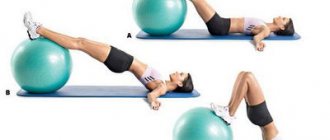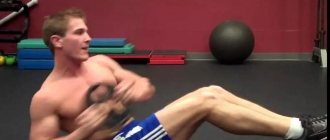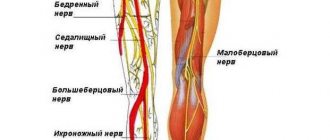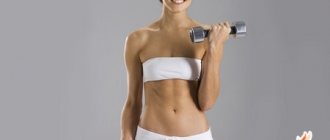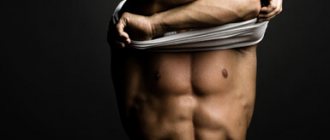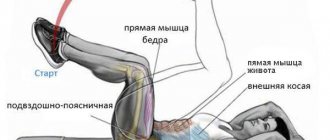29.08.2019 16:37:00
The “climbing” exercise for the abs is an extremely effective cardio exercise that helps strengthen the cardiovascular system and increases the overall endurance of the body. With its help, if performed correctly, an athlete can get strong and aesthetically pleasing abs in a relatively short time.
The basis of the exercise is the “plank” position, which engages the deep muscles and forces them to work with maximum efficiency. No additional equipment or sports equipment is required for classes.
Many athletes choose this exercise as a warm-up, as it allows them to quickly warm up their muscles and prepare for subsequent workouts.
Exercise “Climber”: technique of execution
The compound exercise is familiar to everyone who does cardio, but hardly anyone knows that it has so many modifications. And most importantly, each of them trains the abs perfectly. The main working muscle groups in a “climber” are: obliques, lower abs, pectoralis. Quick movements tone: the latissimus dorsi, lateral and tibial thighs, biceps and triceps, deltoids. Technique:
- models a graceful curve at the waist in women;
- forms “hard abs” in men;
- develops endurance;
- trains the cardiovascular system and lungs;
- burns a ton of calories.
The technically simple practice is intuitive and suitable for intermediate fitness enthusiasts to train at home.
Climber or climber exercise: technique, muscle work, recommendations
The material was prepared by the site team with the support of our experts: athletes, coaches and nutrition specialists. Our team >>
- Reading time: 6 min.
- Advantages and disadvantages
- Techniques and recommendations
- Varieties of "climber"
- With weights
- With a jump
- With body rotation
- Bipedal "climber"
- With a fitness ball
- On the elbows
- With expander
- With sumo jump
- On half-bent arms
- Use in training
Complex multi-joint elements are best suited for tightening the figure and getting rid of excess weight. Today we propose to consider an effective exercise from CrossFit - mountain climber, aimed at working the muscles of the lower body and abs, as well as burning subcutaneous fat.
How to do the mountain climber exercise
Start with the basics - by training the rectus abdominis muscle.
- Get into a climber's plank, similar to a push-up position. The horizontally elongated body should form a straight line from head to heels.
- Move your straight arms under your shoulders, tighten your abdominal muscles. This position is considered basic.
- Fix your body position and keep it static throughout the entire set.
- Bend your left leg and vigorously bring it to your left hand in a straight path.
- Return it to IP and do the same with the opposite leg.
Alternately changing limbs, take quick “steps” in the air. As you exhale, pull your knee towards you, and as you inhale, return it to IP. Work for 30 seconds, controlling your breathing rhythm. During this time, perform approximately 40 leg movements. Increase the number of “steps” gradually.
- Girls perform 3 repetitions in total;
- man – 4-5.
At first, beginner climbers can work with their arms bent, reduce the range of motion of their legs, reaching their knees no higher than the solar plexus. First, try doing it on an exercise ball or resting on a bench. Work according to the same principle, but resting your palms on a support shoulder-width apart.
How to do the rock climbing exercise correctly
- Do not lift your pelvis high.
- Don't bend your elbows, otherwise you will lose your balance.
- When tightening your limbs, do not round your lower back.
- Keep your core muscles constantly tense. This will avoid body swaying and maintain static.
Having mastered the classic technique, move on to more complex modifications .
The “Climber” version with an expander is suitable for those who have mastered the basic technique and decided to increase the load on the muscles.
For this purpose, fix the tourniquet on the quadriceps and then work according to the scheme. Master these techniques first, then move on to more complex modifications.
How to include in training?
By doing rock climbing, you can burn 8 to 15 calories every minute, which is decent, but not enough for weight loss. Therefore, a balanced training program is necessary. The following is an example of a plan for girls, it is aimed at getting rid of subcutaneous fat and improving the tone of the lower body:
- running on a treadmill or jumping rope - 5-7 minutes;
- plyometric squats with jump - 3 x 20 times;
- lunges with weights - 3 x 15 times;
- crossover leg abductions - 3 x 15 repetitions;
- climber - 3 x 30 seconds;
- jogging at a measured pace - 10 minutes.
The male body is designed differently, so they require different loads. Performed after aerobic warm-up, all techniques in three approaches 15 times:
- air squats;
- leg press in the simulator;
- lunges with weights;
- leg extension while sitting in a machine;
- climber with weights on ankles;
- crunches on a Roman bench.
The climbing exercise is recommended for use in functional split training.
"Climber" with jumps
Intensive practice is suitable for trained athletes with developed coordination. In this version, in addition to the abs, the buttocks and calves receive a greater load
- From the base position, perform a jumping movement, bringing your feet as close to your palms as possible.
- Keeping your torso static, group yourself on bent legs, transfer your center of gravity to your toes, then pull both knees towards your torso.
- Jump up and return to a horizontal position mid-flight.
Work at a fast pace to the limit of your physical capabilities. Speed training will allow you to quickly burn the fold on your stomach and work out all your muscles. If you don't have time to workout, include the mountain climber in your morning exercises. Exercising vigorously in the morning with your own weight will tone your body and fill you with energy for the whole day.
Varieties of "climber"
The exercise is used in various disciplines, so many execution techniques have been developed. We propose to analyze the most effective ones.
With weights
Running in a prone position can be made more difficult with the help of sand weights. To begin with, take the lightest pads - 0.5–1 kg. You should not take a large load, as in this case, the equipment will most likely begin to suffer:
- Place weights on your shins and do a prone position.
- With a jerk, pull the thigh of your right leg towards your stomach.
- Then simultaneously move the limb back and lift the other knee towards you.
- Perform continuous running motions for 30 seconds or more.
With a jump
This version of the “climber” is suitable for beginner athletes, since its technique is simpler than the classic one. Before you start training, be sure to stretch your leg joints:
- Take an emphasis lying on straight arms.
- Tighten your abdominal muscles and buttocks.
- Push off with your foot and lightly jump to pull your knee towards you, while placing your toe on the floor.
- Using the same jumping movement, return to the starting position.
- Repeat with the other limb.
Try to move evenly, without pauses. Do 3-4 sets of 12-15 reps.
With body rotation
The exercise creates additional stress for the abs, namely the oblique muscles. It also allows you to increase the stretching of the gluteal muscles and improve the mobility of the hip joints:
- Take a plank pose with straight arms.
- Prepare your body: pull in your stomach, straighten your back and legs, tighten your buttocks.
- Exhale and try to touch your knee to the elbow of your opposite hand.
- As you inhale, return to the starting position.
- Repeat on the other side.
- When performing, do not allow the pelvic area to sag.
- Do 3-4 sets of 12-15 abductions in each direction at an average pace.
Bipedal "climber"
The element is designed for an accentuated effect on the rectus abdominis muscle. In addition, the exercise, thanks to its high-speed pace, allows you to effectively burn subcutaneous fat:
- Get into a push-up position.
- Straighten your body and legs in one line.
- Exhale and with a sharp jumping motion, pull both knees towards your stomach.
- As you inhale, jump back to the starting position.
- When abducting your legs, make sure that your pelvis does not drop too much down. Otherwise, it may lead to a bruise in the groin area.
- Do 3 sets of 25-30 reps at a fast pace.
With a fitness ball
The exercise is performed with the palms resting on a large gymnastic ball. This allows you to reduce the load on the shoulder girdle. In addition, the element helps strengthen small muscles responsible for body balance:
- Choose a comfortable fitness ball with a diameter of 60–70 cm.
- Press your palms into the ball and move your legs back.
- Straighten your arms completely.
- The body tilt should be approximately 35–40°.
- While maintaining balance, exhale and smoothly pull your knee forward until it touches the fitball.
- Then inhale and move your leg back.
- Perform with the other limb.
Avoid rounding the spine. Do 3-4 sets of 12-15 reps.
On the elbows
Thanks to this technique, the element allows you to take the load off your hands and focus on working out the abdominal muscles:
- From a plank position, rest on your forearms.
- Keep your body in one line.
- Exhale, lift your pelvis slightly and pull your knee toward your stomach.
- Inhale and return your leg to the starting position.
- Repeat the movement with the other limb.
- Do 3-4 sets of 12-15 reps.
Execution technique
The Climber exercise can be performed in different ways. The main thing is to follow a few general rules:
- Distribute your weight evenly on your arms and legs.
- While moving your legs, do not roll over to the right or left side.
- Tighten your stomach and keep your muscles tense.
- Don't arch your lower back.
- Straighten your shoulders and don't touch your shoulder blades.
- Bend your elbows, otherwise the entire load will fall on the elbow joints.
- Breathe evenly.
Execution options
Basic exercise "Climber"
Why: Abs and butt workout.
How to: Lie on a mat, place your hands on the floor and place your palms shoulder-width apart. Rise up on your hands without straightening your elbows. Keep your body parallel to the floor. As you exhale, tighten your abdominal muscles and pull your right knee toward your chest. As you inhale, return to the starting position. Repeat the same with your left leg.
Experienced athletes can increase the load. In the video we show how to perform a more advanced version of the Climber exercise with a barbell.
With twisting
Why: Exercise your abs, obliques and buttocks. Additional stress on the pectoral muscles.
How to: Lie on a mat, place your arms shoulder-width apart and place your palms on the floor. Rise up on your hands without straightening your elbows. As you exhale, tighten your abdominal muscles and pull your right knee toward your left shoulder, twisting slightly at the waist. As you inhale, return to the starting position and do the same with your left leg.
With expander
Why: The main load is on the legs and buttocks, training the hamstrings.
How to: Tie a resistance band to your legs just above your knees and do a prone position. Rise up on your arms, bending your elbows slightly. Keep your body parallel to the floor. As you exhale, tighten your abdominal muscles and pull your right knee toward your chest. As you inhale, return to the starting position and repeat the same with your left leg.
Hands on the bench
Why: Workout the buttocks, deltas and core muscles.
How to: Get into a prone position and place your hands on the bench. Palms - shoulder width apart. As you exhale, tighten your abdominal muscles and pull your right knee toward your chest. As you inhale, return to the starting position and do the same with your left leg.
On fitball
Why: Additional load on the biceps, triceps and deltoid muscles.
How to: Lie on the floor and place your hands on the ball. As you exhale, tighten your abdominal muscles and pull your right knee toward your chest. The exercise is performed alternately on each leg.
"Climber" bipedal
Why: Training the abs, biceps, back, deltas, core muscles.
How to: Lie down on a mat. Place your hands shoulder-width apart. Keep your body parallel to the floor. As you exhale, lift yourself up on your arms, tensing your abdominal muscles. As you jump, pull your knees toward your chest and inhale as you return to the starting position. Repeat the exercise several times.
No foot landing
Why: Additional stress on the abs and buttocks.
How to: Lie down with your arms slightly bent. As you exhale, tighten your abdominal muscles and pull your right knee toward your chest. As you inhale, quickly change your left leg. Repeat the exercise.
Diagonal steps
Why: Training for the muscles of the thighs and buttocks. Additional stress on the pectoral muscles.
How to: Get into a prone position and place your hands shoulder-width apart. Your body should be parallel to the floor. As you exhale, pull your right knee toward your left shoulder. As you inhale, return to the starting position and repeat the same with your left leg.
How to do a rock climber for the abs with a turnaround
- Stand in a classic plank position with emphasis on your left palm, and extend your other arm behind your head.
- Bring your left knee bent to the right side of your chest.
- As you inhale, bring your legs together, turn your body and, following the algorithm, repeat the movements for the right side.
Recommendations
To make your training as effective as possible, we recommend:
- For beginners, perform the exercise with your hands on a raised platform and not on the floor.
- Don't rush, build up the pace gradually.
- Don't lift your pelvis too high.
- Monitor the position of the body; the body should form a straight line (from shoulders to ankles).
- Straighten your legs and do not bend your knees.
- Breathe evenly.
- Perform the optimal number of sets – 4–5.
Exercise correctly with the instructors of the Mango fitness club. Sign up for personal training – then the results won’t take long to arrive!
Exercise Climber
The climbing exercise has nothing in common with mountain climbers, despite the similar name. It came to CrossFit from aerobics, and, despite its multi-joint nature, is not considered basic. In particular, it is mainly used as:
- warming;
- training the abdominal muscles;
- as aerobic or cardio.
Note: if additional weights are used, it may well be considered as basic.
But with the correct technique, it can amaze even an experienced athlete with its load. What is the secret of the climbing exercise, and who is it intended for?
Interesting fact: the exercise was successfully used by athletes and dancers during the Soviet school of sports. In particular, it was used as a simplified form of burpee, and the main task was not to prepare the abdominal muscles and leg flexors, but quite the opposite. The exercise, performed at a high tempo, was supposed to increase the strength endurance of future athletes, and most importantly, strengthen the arms and upper shoulder girdle for static load. It was then used in conjunction with exercise balls to improve coordination and prepare the obliques. And only with the advent of CrossFit as a sports revolution, the “climber” acquired its modern form.
About the disadvantages
With all the advantages, there are also disadvantages. First of all, it cannot be used to build muscle mass. Performed under the burden of your own weight, this is an insufficient stimulus for growth. Designed to develop endurance and strengthening, but not hypertrophy.
To get the benefits, you will need to study in detail how to do the climbing exercise correctly and learn to feel the work of your muscles. If done incorrectly, there will be no sense. For example, if you do not control the use of the press, it will be performed only by lifting the pelvis and moving the legs.
The disadvantages include a considerable number of contraindications:
- cardiovascular dysfunctions;
- recent surgical interventions;
- rehabilitation after injuries to knees, ankles, shoulders, elbows;
- diastasis with risk of re-divergence;
- protrusions and hernias, accompanied by pain;
- high blood pressure and predisposition to it;
- pregnancy.
What muscles work?
The climbing exercise works many muscle groups. Its main advantage is its versatility, as it is suitable for both men and women. It will be an ideal start for obese people, because it combines multi-joint and aerobic characteristics. For the complete anatomy of the exercise, see the table below.
As you can see from the table, this exercise uses almost all the muscles on the human body. By using special rubber bands, you can significantly increase the emphasis on the abdominal muscles or leg muscles. Unfortunately, due to the inability to evenly distribute the increased load across the entire body, the climber ended up on the list of aerobic exercises.
How to start practicing at home?
The “Climber” exercise is perfect for practicing at home. Requiring no skills or special equipment, it works exactly those muscles that are necessary for a slim, toned figure. It's no secret that problematic pounds appear most often on the buttocks and thighs. It is on these parts of the body that the main load of the exercise is directed. It gives the muscles maximum load, which once again confirms its effectiveness in the fight against fat reserves.
A simple and at the same time quite effective exercise is also attractive because it can be performed either separately or in combination with other exercises. The main thing in home exercises is the right attitude, a gradual increase in load and regularity of training.
You need to choose the appropriate exercise option. Perform it at a slow pace for several days. Class time at the initial stage is no more than 10 minutes. You need to increase your training time and load gradually.
You can build muscle and keep your body in shape by regularly performing the “Climber” exercise. Reviews once again confirm that this simple exercise can reduce back pain, strengthen muscles and restore flexibility to the spine. In addition, daily exercise improves blood circulation and activates metabolism. By performing “Climber” regularly, you will feel a surge of strength and energy.
Execution technique
Let's look step by step at how to do the exercise correctly. The technique seems extremely simple. However, if at least one of the points is not observed, the benefits of the climbing exercise are significantly reduced.
Let's consider techniques for beginners and more advanced athletes.
For beginners:
- Take a classic lying position (arms are at shoulder level, palms parallel to each other).
- Level the body (no bends or arches).
- Slowly lift one leg.
- Then lower it to its original position
- Repeat the operation with the second leg.
For beginners, it is important to follow the correct breathing technique when performing the exercise, and maintain a confident but stable rhythm. During the active phase of the exercise, exhale. While in the negative phase, inhale. Work in this mode until the deltas completely fail. Those. approximately 60-120 seconds.
For professionals:
Professionals often use more complex variations on the rock climber theme. Be it a variation with a body rotation, or a two-legged version. But you can complicate the simple technique of performing the rock climbing exercise.
- Take a lying “grasshopper” position - your hands are located significantly below shoulder level with your palms placed narrowly.
- Align the body.
- At a fast pace, pull one leg up, touching your knee to the body.
- Then lower it to its original position.
- Repeat the operation with the second leg.
In this case, due to the shift in the center of gravity, almost the entire load is taken by the abdominal muscles, and the deltoids themselves work somewhat more actively, since they are in the highest phase of tension due to the non-standard position.
A more complete technique for the climbing exercise can be seen in the video.
Techniques and recommendations
The climbing exercise is used, as a rule, by trained athletes. But if you are new to fitness, we recommend that you familiarize yourself with the features of the element. Classic technique:
- Lower yourself into a plank position with your arms straight.
- Tighten your core muscles (hips, buttocks, abs).
- Sharply pull your knee towards your stomach, but do not place your toe on the floor.
- With the same quick movement, take your leg back to the starting position and at the same time lift the opposite knee towards you.
- Move without pausing. The exercise should resemble horizontal running.
- Avoid sagging in the lumbar region or, conversely, rounding your back.
- When doing this, keep your arms straight and your head down so as not to strain your neck.
- Try to move only your legs. The body and pelvis must remain motionless.
- The exercise is performed at a fast pace for a while. Beginners should start with 15 seconds per set and gradually work their way up to 1 minute.
The classic version of the “climber” is aimed at maintaining leg muscles in tone, as well as losing weight. If you want to load your abs better, perform the element at a slow pace. The technique will be like this:
- Take an emphasis lying on straight arms.
- Tighten your abdominal muscles and buttocks.
- Exhale and smoothly pull your knee towards you, while inhaling, move your leg back to the starting position.
- Do the same with the other limb.
- Keep your body in one line.
- Avoid swinging your body to the sides.
- Keep your arms straight.
- The exercise should be done for 3-4 sets of 12-15 repetitions.
Contraindications to the element:
- severe cardiovascular diseases;
- pregnancy;
- recovery period after abdominal surgery;
- untreated knee injuries;
- ankle sprain.
Execution Variations
There are several main types of exercise. Each of which is a more complex version of a simple "climber".
- Bipedal climber - allows you to shift the load on your legs and use your heart muscles more strongly.
- Climber with body rotation - maximum load on the abdominal muscles and core.
- The Bent Climber is an extreme option for those who want powerful front deltoids.
- Climber with a load - helps to work out all muscle groups more strongly, in addition, develops explosive speed, useful when running.
Let's consider the technique of each of them as they become more complex.
Bipedal climber
The two-legged climber is designed to take stress off the obliques. Instead, the leg muscles are additionally trained for explosive strength.
How to do it correctly? Everything is very simple (but this does not mean that the exercise is simple):
- Take a lying position - hands are above head level, parallel to each other with a wide grip).
- Maintain a slight deflection in the body (no more than 10 degrees).
- At a fast pace (jumping style), pull both legs towards the body, and then return them to their previous position at the same pace.
In fact, in this case, the athlete imitates the movement of a frog, and a high pace and full use of the leg muscles increases the heart rate compared to a simple climber by approximately 25-30%.
Note: When working with this style of exercise, it is recommended to use a heart rate monitor in order not to exceed the maximum allowable heart rate. Since if it is exceeded, the benefit from the exercise is offset by the increased load on the heart, which, when working at a certain heart rate, receives microtraumas leading to the “sports heart” syndrome.
Climber with body rotation
This is another variation of the exercise that significantly reduces the load on the leg muscles, while maximizing the use of the core and abdominal muscles, especially the oblique and lateral abdominal muscles.
How to do it correctly?
- Take a lying “grasshopper” position - your hands are located significantly below shoulder level with your palms placed narrowly.
- Align the body.
- At a fast pace, pull one leg up, touching your knee to the body.
- At the moment of pulling your leg, turn your body in the direction of the turn.
- Stay in this position for about 5-10 seconds.
- Rotate the body to the starting position with the return of the leg.
In this case, it is considered that the climbing exercise is performed for the abs . Therefore, it can be used in combination with burpees, or with other sets of exercises that involve the oblique and lateral abdominal muscles.
To complicate the exercise, additional professionals, when turning the body, extend their arm upward, leaving their weight on the 1st leg and 1st arm. In this case, additional emphasis is formed in the athlete's deltas.
Climber with bent arms
This variation is almost identical to the classic exercise with the exception of one small nuance. To maximize the load on the deltoids and triceps, the arms in the starting position do not rest on the joints, but are slightly bent (as in the first phase of push-ups) and remain in this position until the end of the approach. This increases the load on the entire shoulder girdle and makes the exercise technically difficult.
Technical recommendations
You can move on to the most interesting options only after you have mastered the classic one perfectly. Many are intended only for athletes with excellent training; inexperienced people cannot do them.
Classic version:
- take the starting position of the plank;
- tighten your core muscles, it is especially important to feel the tension in the abdominal area;
- sharply bend one knee and pull it towards the chest without touching the ground;
- return to the original position in the same way;
- repeat immediately to others.
Mandatory rules for the exercise of a climber in a prone position:
- movement without pauses so that it looks like jogging while lying down;
- make sure that your back does not round or sag in the lower back;
- arms do not bend;
- the head is slightly lowered so that there is no excessive tension in the neck;
- the upper body is fixed, only the lower limbs change their position;
- the faster you do it, the higher the efficiency;
- how much to do depends on preparation. The minimum duration for beginners is 15 seconds, then this period should be extended to a minute.
This variation is aimed at increasing tone and accelerating weight loss. As a general tonic, it is suitable for children and people in poor shape. It will not be possible to monitor correctness through a mirror, since the gaze must be lowered. Therefore, it is necessary to ask someone to monitor it from the outside or record it on video, then view and analyze the errors.
If you want most of the tension to go to the press, then do the same, but slowly: pull your knees not sharply, but smoothly. With this design, you will have to monitor the stability of the case so that it does not sway. The body is represented by a line from the heels to the crown. With the slow version, you don’t need to time it; it’s more objective to count the repetitions. The optimal volume is four sets of 15 repetitions.
Other recommendations:
- The arms should be constantly straightened for stability, as well as to shift the emphasis to the abs. If you do it on the elbows, then the biceps and triceps will take on part of it; the abs will not receive enough tension until fatigue, which will come faster. The fact is that the press is very hardy; in order to give it enough work, you will have to try;
- The head should not be thrown back or lowered so that the chin approaches the chest. If you do not follow this, the neck and trapezius will be under tension, which will lead to pain in them after exercise. You shouldn't look left and right for the same reason;
- You cannot relax your back, as this will cause your chest to begin to sag towards the floor. This creates a danger for the shoulders and aggravates lumbar lordosis;
- performed sharply, but not by jumping. Despite the high tempo, actions must be rhythmic and uniform;
- don’t just move your hip forward and send it back, but strongly strain your abs and bring your pelvis to the bottom of your chest;
- the knee moves forward as you exhale, and back as you inhale, this ensures correct distribution of work;
- The pelvis should not go up, so it is important to ensure that the hip joint does not bend.
Exercise rock climber
The “climbing” exercise for the abs is an extremely effective cardio exercise that helps strengthen the cardiovascular system and increases the overall endurance of the body. With its help, if performed correctly, an athlete can get strong and aesthetically pleasing abs in a relatively short time.
The basis of the exercise is the “plank” position, which engages the deep muscles and forces them to work with maximum efficiency. No additional equipment or sports equipment is required for classes.
Many athletes choose this exercise as a warm-up, as it allows them to quickly warm up their muscles and prepare for subsequent workouts.
Advantages and disadvantages
Thanks to the fast pace of execution and the active work of the leg muscles, the exercise allows you to strengthen the heart muscle - the myocardium, as well as the respiratory organs. As a result, the athlete becomes more resilient, faster, and his cardiovascular system improves. This type of exercise reduces the likelihood of developing heart disease.
The second advantage of the exercise is muscle development. The main load is received by:
The element is performed while lying on straight arms, which means that the impact is on the triceps and partly the back muscles. In addition to muscle fibers, ligaments and tendons throughout the body are also strengthened.
“Climber steps” involve large muscles (quadriceps, glutes). Thanks to this, the athlete burns a large number of calories, which helps to effectively get rid of extra pounds. Weight loss is also facilitated by the fast pace of exercise, which affects the acceleration of metabolic processes in the body.
The disadvantages of the “climber” include its unsuitability for building muscle mass. The element technique is based on using your own body weight. Because of this, the muscles do not receive the necessary force load, and, therefore, cannot hypertrophy. The exercise is intended only to strengthen muscles and develop their endurance.
What does the “climbing” exercise do?
The “climber steps” exercise loads different muscle groups, so it can be considered not only effective, but also truly universal. If you follow the technique, training not only strengthens your abs, but also engages other muscles and helps keep them toned. The exercise allows you to:
- strengthen the deep muscles of the trunk, which provide stabilization of the spine;
- tighten your abs, legs and arms;
- maintain spinal health;
- get good posture;
- increase the elasticity of ligaments;
- compact bone tissue;
- intensively burn calories for weight loss;
- form a sculpted, beautiful press.
The benefit of the “climber” exercise also lies in the fact that with its help you can increase the vitality and endurance of the body, necessary for strong physical exertion.
Safety and precautions
Climbing exercises of any variation depend heavily on your ability to get into and hold the correct board position. Make sure that:
- Your arms and hands are positioned straight down from your shoulders.
- Your back is straight and flat, not arched or arched.
- Your hips should not be lifted (your butt should not be in the air).
Performing an exercise with poor form can put you at risk of injury and will significantly reduce the effectiveness of your workout.
Climbing is an exercise that can be performed in the gym, at home or on the street. This is one of the most effective exercises for the abs and complex work of the muscles of the whole body.
What muscles work in the rock climber exercise?
With regular training, the exercise allows you to achieve very quick results; the technique uses both the abdominal muscles and other parts of the body.
What muscles work:
- Core muscles. Deep muscles responsible for fixing the spine.
- Muscles of the body. Rectus and oblique abdominal muscles, hip flexors and extensors, responsible for body orientation.
- Leg muscles. The calf muscles, shin and foot flexors, and quadriceps femoris muscles provide overall fit to the body.
- Upper body. The pectoralis minor, serratus anterior, abductor and adductor scapulae, affecting the overall tone of the human body.
- Shoulder girdle. Deltoid, pectoralis major, triceps, shoulder flexors, forearm extensors - provide overall tone and fit of the body.

